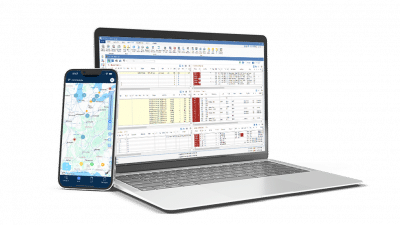Manual check-ins and disconnected systems slow your team down. Real-time visibility gives you a faster and clearer way to track every shipment.
Most logistics teams spend too much time hunting down shipment details. Their attention is split across multiple carriers, transportation modes, and disconnected systems. Without a clear view of what’s happening in real time, delays often catch teams off guard and make it harder to respond quickly or keep customers informed.
Real-time transportation visibility (RTTV) brings all your tracking data into one place. It gives your team a live view of every shipment, so they can spot issues early and respond quickly.
In this post, we’ll break down:
- What real-time transportation visibility means
- The key technologies that make it possible
- The benefits for logistics teams and customers
What Does RTTV Mean for my Fleet?
At the most basic level, RTTV allows you to track shipments minute-by-minute without logging into a dozen different portals or waiting on check calls.
These systems pull together data from GPS devices, ELDs, telematics, transportation management systems (TMS), and carrier integrations to give you a single, live view of your freight in motion.
Instead of chasing updates, your team can see:
- Where every load is in real time
- When it’s expected to arrive based on actual traffic and movement
- Whether it’s running early, on time, or delayed
- Which shipments need attention before your customer asks
These capabilities operate as an automated and connected freight visibility system, giving you more control.
The benefit of real-time transportation visibility
When your team can see where every load is, they can plan, adjust, and keep freight moving.
Any real-time transportation visibility capabilities give dispatch the data they need to reroute around delays. They help warehouse teams prep for incoming trucks without guesswork. They also let customer service give accurate updates without digging through emails or calling carriers.
RTTV turns fragmented updates into a unified, real-time view of your freight network. Below are a few ways to see it in practice.
Improving ETA accuracy with live GPS and ELD data
Static ETAs are almost always wrong. There’s usually some type of traffic change or incoming weather causing delays.
Visibility platforms with real-time GPS and ELD data help you avoid using outdated estimates. You get a live picture of where each truck is, how fast it’s moving, and when it’s likely to arrive. This is based on real-world conditions.
Dispatch gains the ability to make informed adjustments and gives customers a more reliable ETA.
Reducing check calls and emails by centralizing information
One of the more powerful real-time transportation visibility capabilities is the centralization of information for your team. Chasing updates through phone calls and email chains takes up time in the workflow. It can also lead to conflicting information across departments.
A RTTV system eliminates the need for constant outreach by putting shipment data, driver status, and movement history in one shared platform. Whether it’s dispatch, customer service, or warehouse staff, everyone has the same, accurate view.
Surfacing delays automatically to prevent escalation
Late deliveries do happen. Real-time transportation visibility capabilities let you set geofences, track missed milestones, and trigger alerts when something’s off. If a driver misses a scheduled stop, sits too long at a dock, or strays off route, the team is notified.
Strengthening communication across dispatch, warehouse, and customer teams
When information lives in separate systems, there’s a higher chance for miscommunication. Dispatch updates a delivery window, but that change never makes it to the warehouse. Or a driver misses a scheduled stop, and customer service doesn’t find out until the receiver calls to ask where the truck is.
A strong visibility platform creates a single source for all operations teams to work off of. Dispatch can see which loads are on schedule, and the warehouse knows which trucks are arriving next. Plus, customer teams can give real answers without stalling or guessing.
Increasing trust by giving shippers and customers proactive updates
When a customer asks, “Where’s my load?” they want answers quickly and an exact location with an updated ETA. But that’s not always possible.
RTTV lets your team stay proactive. Real-time notifications and accurate ETAs update customers before they even ask. Over time, this adds up to build credibility with every client.
What Powers Real-Time Transportation Visibility Capabilities?
Behind the scenes, real-time transportation visibility capabilities are powered by a few key technologies working together:
- GPS and telematics: Telematics hardware installed on trucks, trailers, and assets provides constant location updates, movement data, and vehicle status. These systems track and capture speed, idle time, detention, and arrival history.
- Electronic logging devices (ELDs): When connected to your visibility platform, they show whether a driver is moving, stopped, waiting, or out of hours.
- TMS platforms: A transportation management system (TMS) like PCS pulls together dispatch, routing, tracking, and billing so every stakeholder works from the same set of data..
- Carrier and broker APIs: RTTV depends on pulling in location and status data from external carriers, brokers, and 3PLs. These direct system-to-system connections automate updates and eliminate the need for calls, emails, or spreadsheets.
- Mobile apps: Mobile tools allow drivers to send updates, receive dispatch instructions, and share proof of delivery in real time.
All of these tools help power real-time transportation visibility capabilities. But when you’re looking for a system to manage all of these behind-the-scenes systems, what should you look for?
What to Look For in an RTTV Program?
There are dozens of platforms promising real-time transportation visibility capabilities. Some only track certain carriers. Others update every 15–30 minutes and not exactly in real-time. There’s also a heavy reliance on check-ins or email updates behind the scenes.
Here’s what separates a winning RTTV system from the crowd:
- Live updates every few minutes: Visibility platforms that refresh every 30 or 60 minutes can’t keep up with what’s happening on the road. Immediate and live updates. You need updates to help avoid tight ETAs and waiting customers.
- Multimodal coverage: Shipments rarely move through one mode from origin to destination. You might start with long-haul truckload, hand it off to a regional LTL carrier, and finish with a final mile delivery. If your platform only tracks one segment, you’re most likely getting fragmented information. Real-time transportation visibility capabilities should follow freight across every leg of the journey.
- Carrier-agnostic tracking: If your visibility stops when you subcontract a load, it’s putting a limitation on the entire process. A winning RTTV platform pulls in data whether the truck is yours, leased, or brokered out.
- Integrations with TMS, ELDs, fuel programs, and planning tools: The RTTV program you’re using should plug into the systems you’re already using. These include TMS, ELDs, routing software, load boards, and fuel programs.
- Exception alerts to flag immediate issues: Exception alerts notify your team the moment a load misses a checkpoint or veers off route. The system surfaces problems automatically so you can act fast and keep freight moving.
- Mobile access: Real-time transportation visibility capabilities work best when they can operate from anywhere. Mobile access lets teams respond to delays, check load status, and manage handoffs without needing to be in the office.
- Unified system view: Routing, tracking, alerts, and status updates should all live in one place for ease of access. The team gets a unified view of the entire process and can easily pinpoint roadblocks or delays.
These different key points to look for in an RTTV system are found in the TMS software PCS provides.
Streamline Your Fleet Operations with PCS
PCS TMS gives your team real-time transportation visibility in one powerful platform, combining dispatch, routing, tracking, and accounting in a single view.
Ready to simplify operations? Schedule a personalized demo to see how the PCS TMS can help streamline dispatch and delivery workflows.
FAQ
Track-and-trace relies on scheduled updates and manual check calls. Real-time transportation visibility capabilities give you continuous GPS and system-level updates.
Yes. PCS tracks truckload, LTL, and intermodal freight across carriers in one place.
Absolutely. PCS integrates with more than 70 external systems, from fuel cards to compliance tools to telematics providers.
PCS automatically flags late loads, missed stops, or route issues and alerts your team so you can take action before a delay turns into a larger issue.



